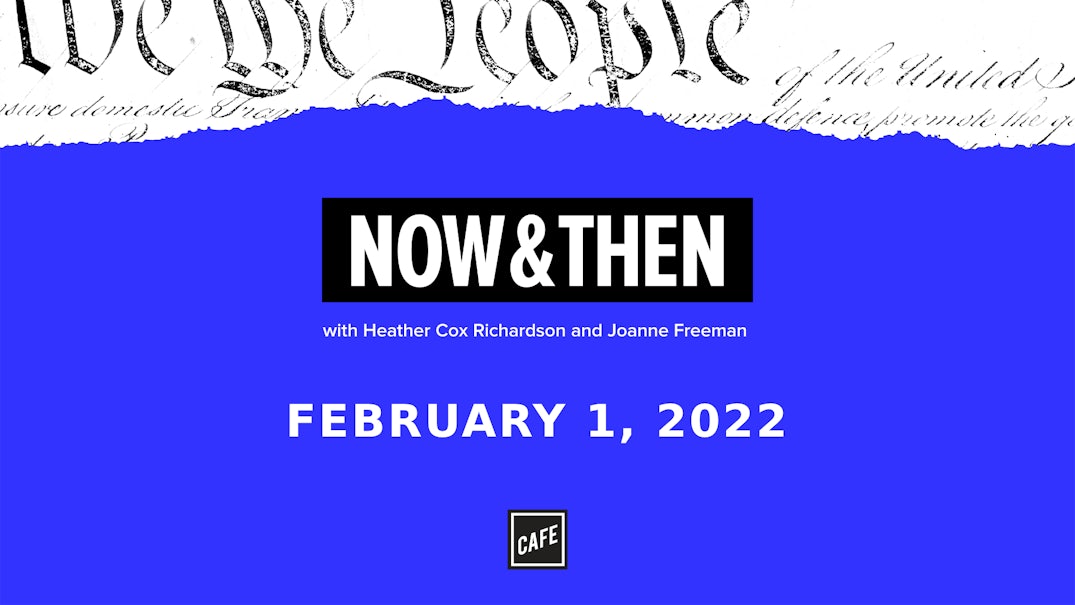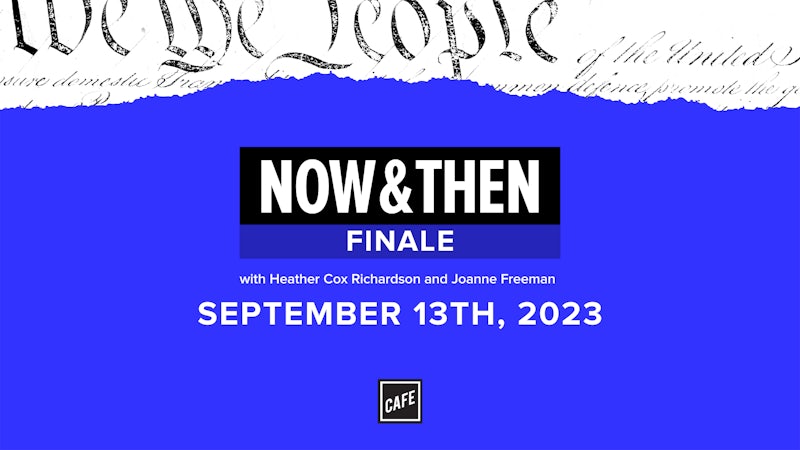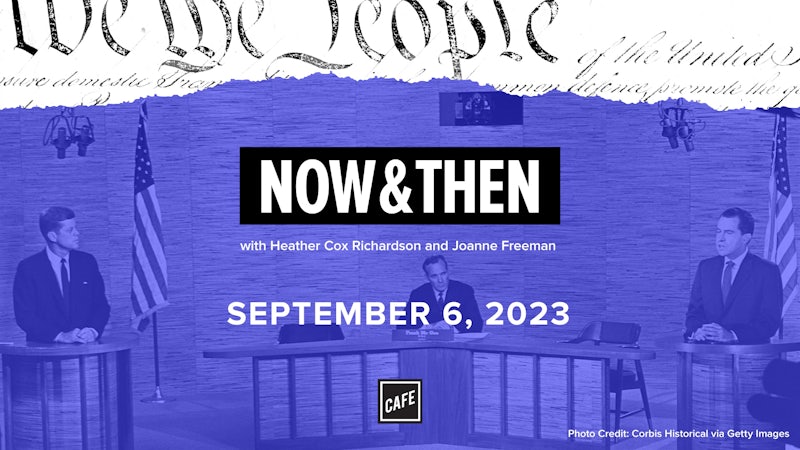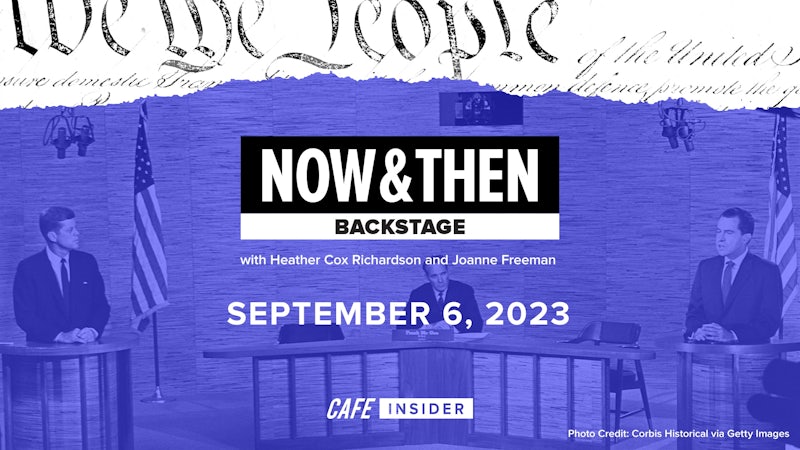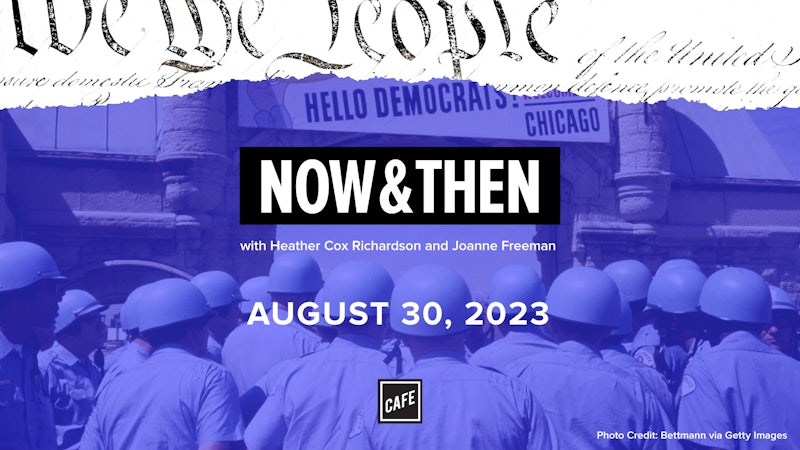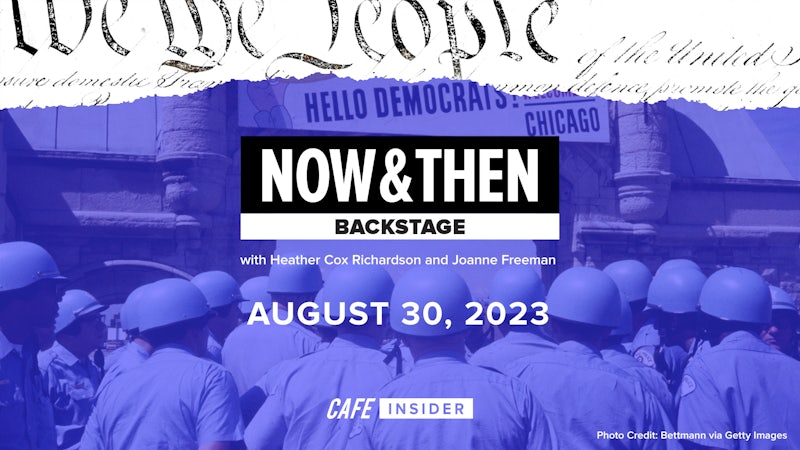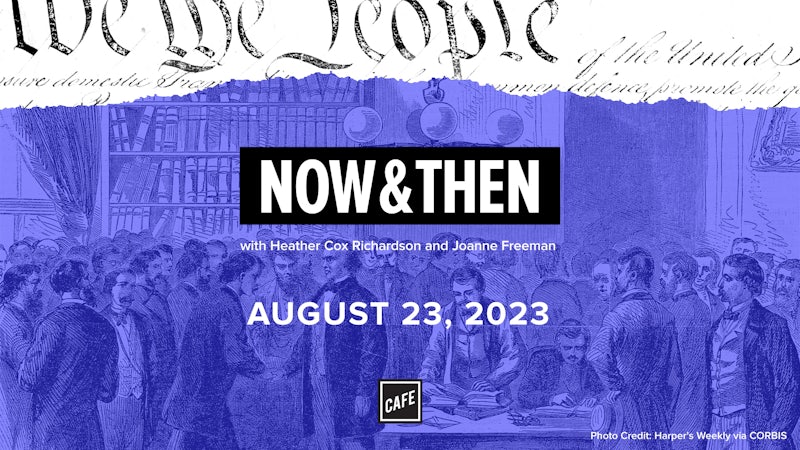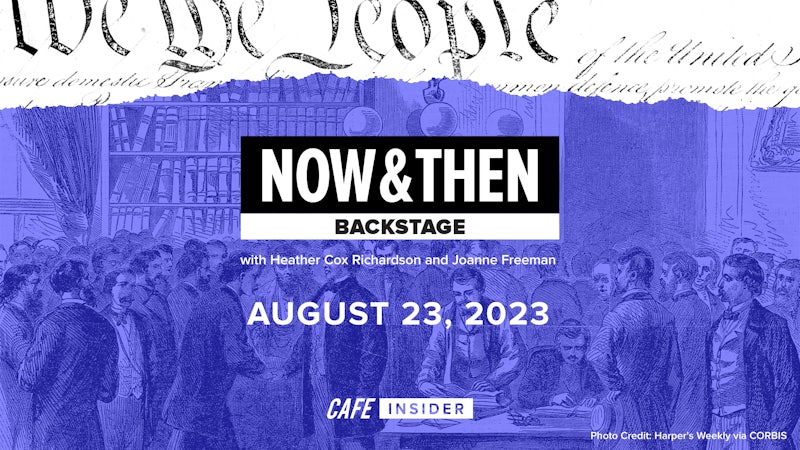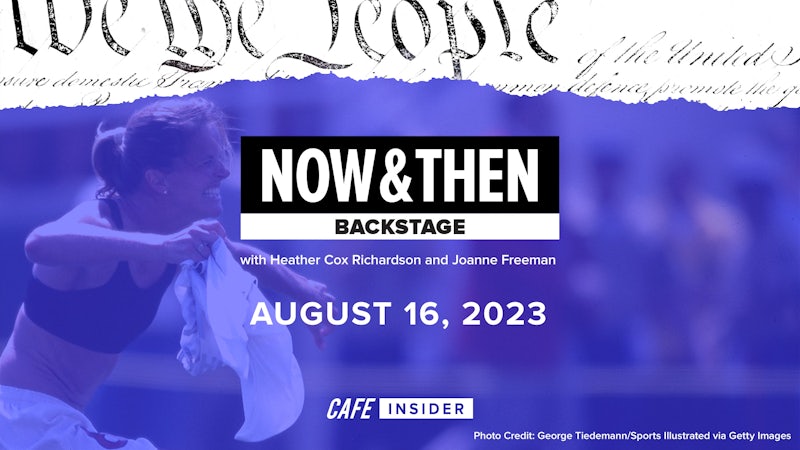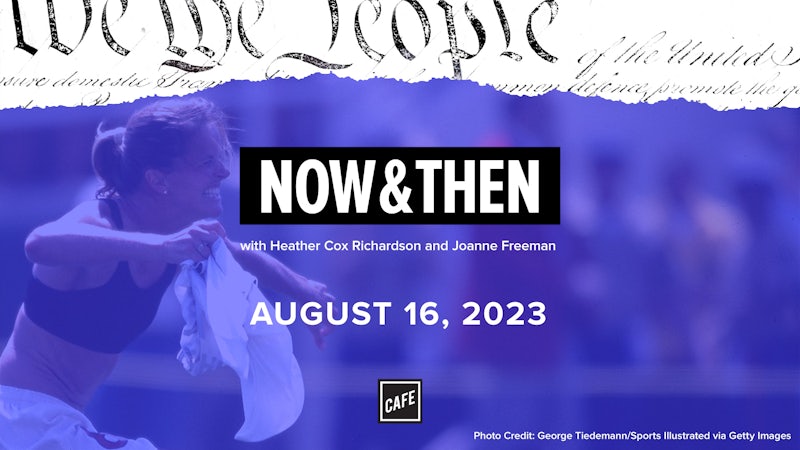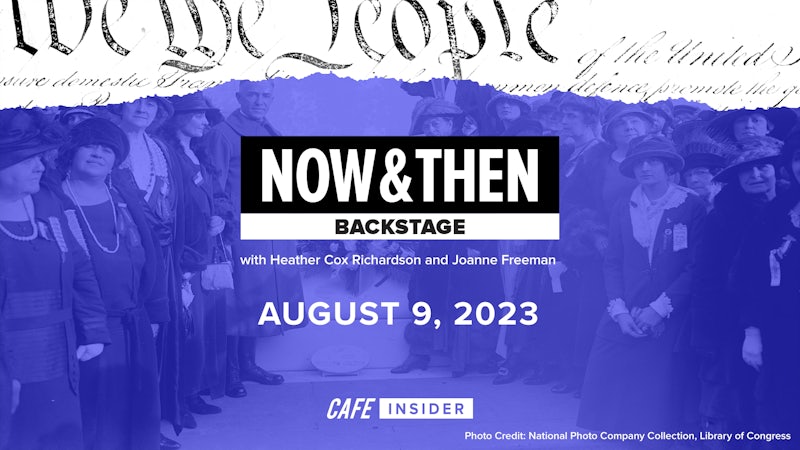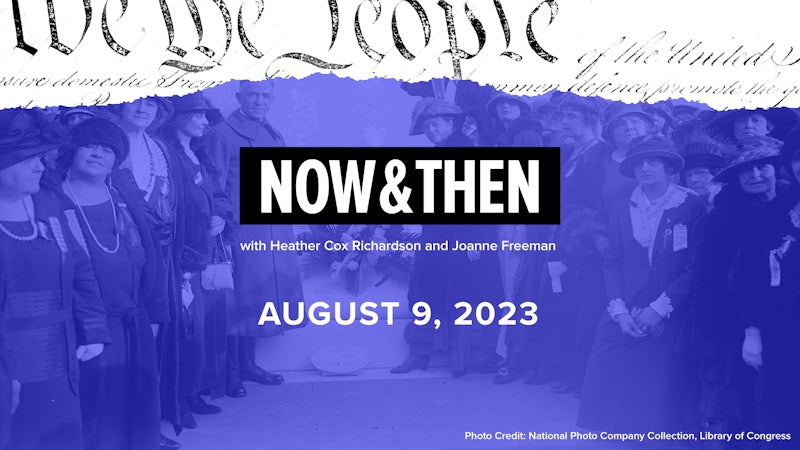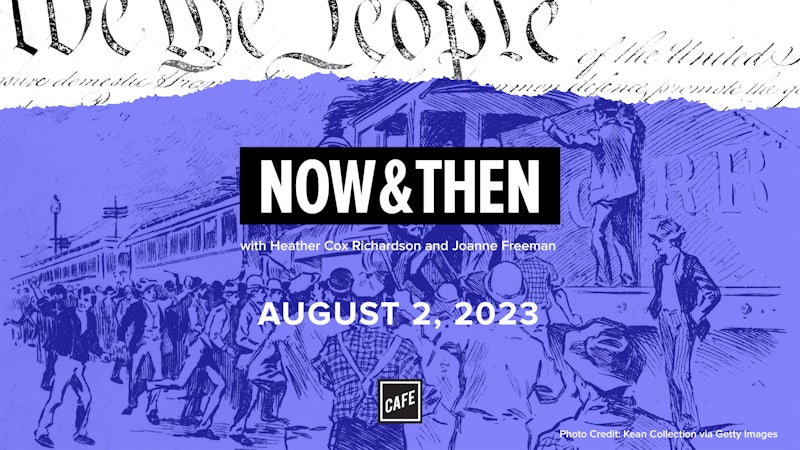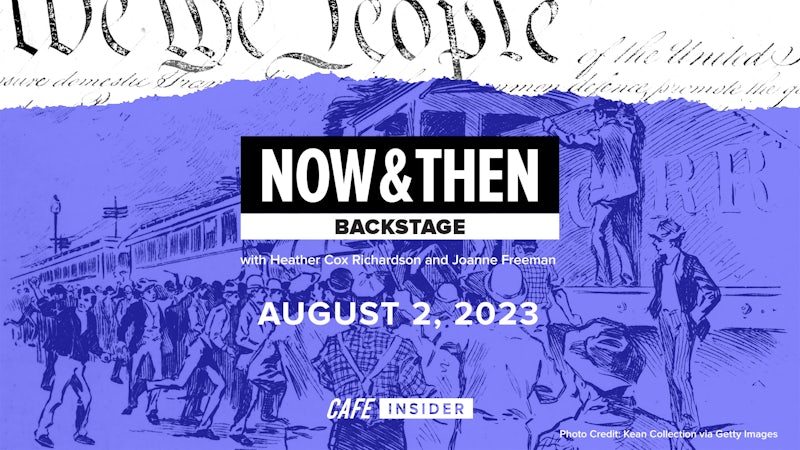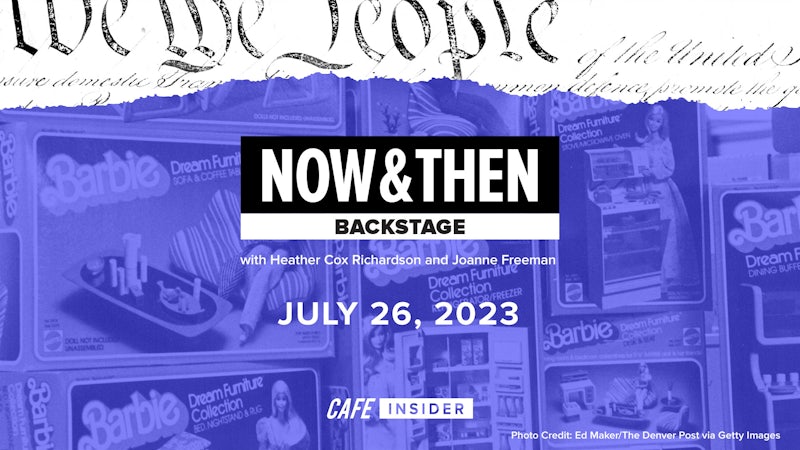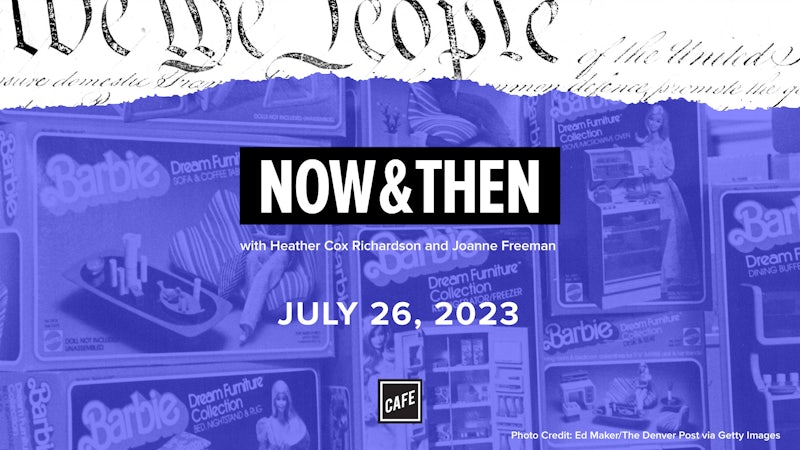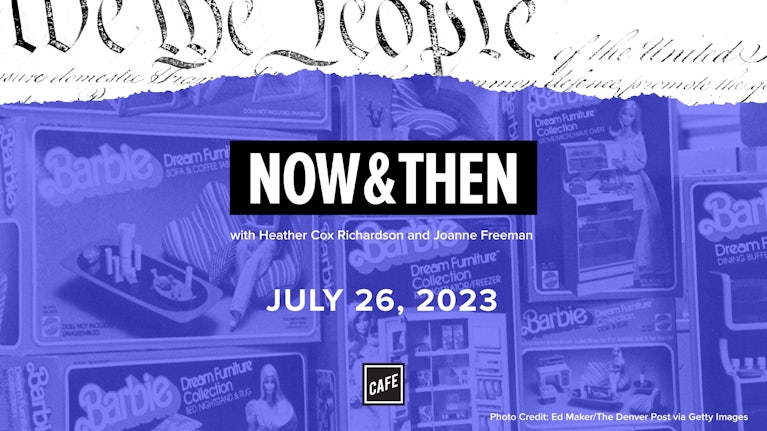Heather Cox Richardson:
From CAFE and the Vox Media Podcast Network, this is Now & Then. I’m Heather Cox Richardson.
Joanne Freeman:
And I’m Joanne Freeman. Today we want to talk about a topic that came up early when we were pondering what we wanted to talk about last week, Heather. But what was interesting about it, and I will say that even as late as 10 minutes ago, we were still talking about the meaning of a lot of things associated with it. We want to talk about basically money, but we don’t want to talk about very specific things about currency and the stock market. What we’re really interested in talking about is what money means. And part of what prompts this conversation is discussion about Bitcoins and cryptocurrency and all of these things floating around out there that are constantly in the public realm. Everyone’s talking about them, but you and I, Heather we’re trying to basically get down to the specifics about them ourselves.
So what’s interesting about that is I think we take money for granted. Not that we have it, but what it means and what it is and what we do with it. And I think the ongoing conversation, which cryptocurrency and Bitcoin in one way or another are forcing us to rethink what money is and what it does and what we think of it and how we relate to it. That’s what we want to talk about today. Over time, how money, currency has shifted meaning over time and what it suggests about the people using the money and about the nation as a whole. What can money tell us about the United States at a given moment in time?
Heather Cox Richardson:
And it’s a great place to start with Bitcoin because even if you don’t know what it is, you’ve probably heard of it. And some people think of it as being edgy and being cool and being a new way of exchanging things that is not regulated by the government so it’s going to open an up room for new entrepreneurs. On the other hand, people think about it as being the latest tulip craze, and this is unintelligible. And this is just something that a bunch of people are playing with to get a leg up over everybody else. So we have all these different opinions about this specific form of exchange that most of us don’t even know what it is.
So it’s a great way to talk about what money has meant culturally, as opposed to, for example, the laws that regulate our money, which is very specific. We can put it on a piece of paper. We can talk about it. And on that note, Joanne, I just have to point out that we’ve been doing this close to a year. And I think every week I’m like, “Can we talk about money this week? Can we talk about money this week, please?” Because I love the laws behind money. I love exchanges money. I love all that historical realm and the entire rest of the world thinks it’s incredibly boring. So we have managed to sneak in money without doing any of the boring parts of it.
Joanne Freeman:
I will totally vouch that. You’ve been saying, “Money? Is it the money week?” However, what do I always say? Culture, culture. I’m really interested in culture. So look what we’ve done this week. It’s the week where we weren’t even trying to do that.
Heather Cox Richardson:
Well, actually some of us were trying that you noticed I said, “Let’s do culture, Joanne. Oh, how about money?” I’m teasing. I’m teasing. But it-
Joanne Freeman:
That’s not how it happened although I also don’t remember.
Heather Cox Richardson:
So let’s start with that period that no one really cares about, the early stuff.
Joanne Freeman:
Almost every week you say that, actually, [inaudible 00:03:36].
Heather Cox Richardson:
Anyway, so what about money early on? Can I just ask, every time you read in colonial history, I can’t believe I’m even going to say this, but you have that funny little L, that’s a pound, right?
Joanne Freeman:
Well, yes. And so that’s-
Heather Cox Richardson:
But it’s not the same pound as the English pound, is it?
Joanne Freeman:
Well, it might be. That’s a good question because what it hints at is the fact that particularly in colonial America, but still moving on into the 1790s, there were many different countries’ currencies circulating within the colonies. The colonies themselves made their own currency sometimes. There were coins, but then there were also paper currency. There were Spanish coins circulating. There were British coins circulating. It was remarkably complicated. It was, in some sense, unstable because you really had to figure what were you holding and what was it worth? And what did it mean? And where did it come from? And was it real? You couldn’t take a lot for granted when it came to money. And so just as an object, you had to think really hard about what you were using, what you were spending. There were things called commodity notes, for example. Virginia used them a lot and they were currency, but they were based on tobacco.
So you would have a certain amount of tobacco of a certain value and you could put that forward and say, here, you have this amount of value that you would like a bill for. And a bill would be made, a tobacco bill which you could then use and whoever got it could then cash it in for the tobacco at that price. So there were all kinds of interesting weird things floating around in the world of currency. Sometimes money mattered a lot in small quantities in this time period. I remember once at the Library of Congress finding an almanac that belonged to Roger Sherman, who was one of the people who was behind the writing of the Declaration of Independence, helped with the creation of the Articles of Confederation. He’s like Mr. Founding Guy.
And what he had done in his almanac is in the blank spaces. He recorded the expenses of his trip from Connecticut to Philadelphia. And what you see is two cents for, hey, three somethings, unclear what kind of denomination for lodging. Calculating these tiny amounts, which were not so tiny at that point, but were important to keep track of and yet were so variable that you had to be careful about how you were recording them and what you were doing with them. He wanted to be reimbursed. So he had a really good reason to be recording them.
Heather Cox Richardson:
So you would literally have a pocketbook full, whatever, of pounds and of tobacco money from Virginia or some similar commodity, something from Connecticut. And you’d have to guess and negotiate with, say an innkeeper about what he or she would take for money.
Joanne Freeman:
There had to be careful consideration about what you were using. Now, I will say coins were made of some kind of a precious metal, so they weren’t floating around in great quantities a lot of the time. So what you were looking at was various forms of printed money and at just as you’re saying, different places, different kinds, different things, backing them. Even when the Continental Congress starts issuing money during the American Revolution, it’s not like they can tax to back up whatever these bills are worth. So consistently in this period, you’re looking at a very complicated system, which you had people using bank note tables and math textbooks and counterfeit detectors and all kinds of charts and everything else to try and figure out the value of whatever it was that was passing through their hands.
Heather Cox Richardson:
Can I ask you one more question about that before we go forward? And that’s that you just said that you might have money circulating from Spain and wherever else. Now, it doesn’t surprise me that the British Crown didn’t necessarily care deeply about a tobacco merchant, for example, having money because that was within a colony, but wouldn’t they have been upset about the money circulating from another country, which I assume comes in through the ports?
Joanne Freeman:
I actually don’t have a definitive answer to this, although my answer would be, is there anywhere in the world that has that kind of blank slate of currency? I mean, like in the Caribbean, for example, Hamilton comes from the Caribbean and when you look at his records and things from when he was there and working in trade, you see the same thing reflected in those books that he’s working with, all different kinds of currency, all different kinds of places, mostly coin. So that’s a big difference here is between countries that are using coin in one way or another in trade and then paper money being pumped out used more often in everyday affairs.
Heather Cox Richardson:
I love the degree to which this illustrates just how cosmopolitan early America was. I mean, if you think about money as a representation of trade and of peoples and of exchanges with other countries, I can’t even imagine trying to negotiate your way across several colonies, handling different monies and all these different pieces. But if you think about how that emphasizes the polyglot multicultural nature of things, it’s really evocative.
Joanne Freeman:
And it’s really a direct symbol of the degree to which there isn’t a strong national something yet at this point. There isn’t a single national currency of a sort that we take for granted now. There are all kinds of different state currencies. The Continental Congress during the revolution is pumping money out. But many of these kinds of currencies, they don’t necessarily have to be accepted when you go to pay that it’s very possible for someone to say, “I don’t know this bill or I don’t trust this bill. I’m not going to take this bill.” So it was complicated. And that’s fascinating also in part, because of the extreme significance of trade and money and what people at the time would’ve called money men. It’s not like this is a side issue. It’s the reason the colonies were created in the first place.
Heather Cox Richardson:
So a lot of it is about trust and about how you feel they’re handling their finances. I mean, if a person is handing out the money based on that barn full of tobacco and you happen to know that that barn is burned, you’re going to have a different relationship with that money and with that guy than if you don’t know the tobacco barn has burned.
Joanne Freeman:
It’s a system that relies in some way on either personal relationships or knowledge that people have of each other. It matters where the money’s coming from, who had it before you. In that sense, money is a very different thing on a local level than it is later on. Not even we’re talking modern times, but yeah, it was about relationships and it was about credit in every meaning of that word. So if you think about the word credit, it can mean the value or worthiness of something, a country, national credit of one kind or another. But it’s not accidental that that word also can mean reputation, what you’re worth personally, who you are personally, and all of that is built into the way in which people are using money in this time period.
Heather Cox Richardson:
All right. So let’s go then to the next phase that you just mentioned, and that is when the Continental Congress during the American Revolution tries to establish its first national currency. And I don’t feel like we have to spend forever on this, but it was interesting when we were talking about it that not only I remembered my mother using an expression from that era, but one of our producers who is in his twenties, I think also remembers his own mother using an example from that period.
Joanne Freeman:
Right. And I wrote down in my notes when I was preparing to talk to you today. I wrote this saying down with a question mark, because I was like, “Does anyone still say this?” And the answer came to me before we even started. So the short version of this is that during the revolution and after, actually, it makes perfect sense that to fund a revolution with a country that is still in formation and doesn’t know yet if it will be a country, ultimately that funding that war and figuring out how to do that without the ability to tax is a huge, huge issue.
So at a certain point in the war, the Continental Congress begins pumping out paper money. And throughout the course of the war, they issued almost $2 million in paper money to cover war time expenses. But because they had no power to tax because wasn’t necessarily anything backing that money, it really depreciated very quickly. So it wasn’t as though the Continental Congress put money out and everyone was happily blithely using that money because they knew it had real value. It did not have a stable value. And that value was sinking all the time. And the saying that I scribbled on my paper that I wondered if anyone ever said is, you sometimes can call something of little value. You can say, “Well, that’s not worth a Continental.” And I knew that saying because I’m an early Americanist, but Heather, you told me your mother used to say that.
Heather Cox Richardson:
My mother used to say that. And one of our producers’ mothers still says it, that, “If something is worthless, it is not worth a Continental.” And if you think about what that said about the value of a national government all those years ago, that it is still in, I can’t believe I’m going to say this, but still in currency in popular expressions for something being worthless. That says a lot about what it meant for the government to create a national currency and then have it turn into what we know as rag money, as in not worth the rags it’s printed on, because paper was made of cotton fiber in that era. And I just find it fascinating that that expression has continued on as so many of the expressions in that time that you’ve told me over the years. I’m like, “What language are you speaking?” Because it’s fallen out of the thought of any kind of popular knowledge, but that one is still going strong, it’s not worth a Continental.
Joanne Freeman:
It’s true. And the ones that tend to continue, the ones that survive are often ones that have this sort of deep, basic value that’s so apparent that you almost don’t need to know the meanings of the words to get what the saying suggest. So it’s fascinating that that saying survives. I’m going to guess that there are people out there listening right now to this episode who knew that saying and never thought about where it came from, but it dates back to the American Revolution.
Now, money continues to be a huge issue. The nation wins the revolution, creates a constitution, moves on into nationhood, but still there’s huge war debt. There still is not one single currency in the United States. They have to talk about that and think about that. And of course there’s Hamilton at the center of a lot of this coming up with a variety of different kinds of plans as to what currency should be like. But again, what’s interesting among other things about that discussion is people thinking about what money should be. And by that, I mean, for example, there’s a discussion about the denominations of money. So how low, how small should coins be in value? And Hamilton among others are argues you have to have coins of really, really little value because you have to get Americans used to using these coins, used to using this money. And the only way to do that is going to be to create a currency that basically poor people can use and can integrate into their lives.
Along similar lines, you have big questions very early on about what that money should look like. And this was a very controversial issue because it touched on one of the third rails of this time period in the United States, which is monarchism, the fact that the United States might slip back into a monarchy. There was discussion in Congress as to whether George Washington, his image should be on coins. And some people thought that that was quite logical and other people quite logically thought that that seemed rather monarchical, that that’s what you do with kings. You put them on coins and that doing the United States was dangerous.
Now, many people, including Hamilton, understood that the image that would appear on a coin would have what Hamilton called a useful impression. So this was going to shape potentially national culture and what people thought about the nation, but there is a congressional debate about what should be on these coins. So for example, Virginia representative John Page suggested that Washington had enough honors already. Why did we need to do this? And it would probably in some way or another alienate other nations. And these are his words, “However well pleased they might be with the head of the great man now their president, they may have no great reason to be pleased with some of his successors. As to him, they have his busts, his pictures everywhere. Historians are daily celebrating his fame and Congress have voted him a monument, a further compliment they need not pay him, especially when it may be said that no republic has paid such a compliment to the chief magistrate and when indeed would be viewed by the world as a stamp of royalty upon our coins.”
And the discussion went that way, it’s going to seem monarchical. It’s going to punch a hole in the identity and nature of the new republic. And Washington’s image is not ultimately put on coins. You get general images of what would’ve been represented at the time as liberty. And then that becomes controversial because liberty is associated with the Figure of Liberty and the French Revolution and liberty caps. So the culture of money is endless and always controversial. But in the United States, because it’s such a symbol of independence and nationhood and because like so many other things in the founding period, it’s so weirdly deliberate and so specifically placed in time, it ends up creating debates that are really interesting and that really exposed the deeper meanings of things that we take for granted.
Heather Cox Richardson:
Well, it’s really important to point out that if people are carrying national money, they are literally carrying a picture of something that symbolizes the country so that we don’t necessarily think about it so much nowadays if you carry your credit card, at least I never even look to see what’s on it. I think it’s just a color. But in a time when artists’ representations were not common, we didn’t have magazines circulating everywhere, newspapers every day, the internet, all the things where we see images all the time, having a token that had a picture on it told an incredible story. So the idea that you would literally be carrying around a picture of something that had been approved by a government implied a kind of community around that set of values. So it doesn’t surprise me at all that they were talking that way. And I have to say it doesn’t surprise me at all that people were uncomfortable putting one guy on it, because then wouldn’t you have to put the next guy?
Joanne Freeman:
Well, that’s exactly what Paige says, “We love Washington, but we might not feel the same way about the next guy.” And for all of the problems that that generation had, they did often think about what happens in five years? What happens in 10? Because they’re establishing patterns. So that’s a really good question. And it really does harken back to what you do with kings and the big fear in the United States is whatever we do, we don’t want another one of those. So it does make perfect sense.
Heather Cox Richardson:
So that issue of what you put on your currency on paper currency is one of my favorite aspects of doing currency in America. The money that circulates in the early 19th century after the dissolution of the Bank of the United States is backed by charters from state governments. So similar to your story about the tobacco being the basis of a currency and for the states, generally there were other state bonds that people would invest in and then be able to issue money based on that. And then they would put pictures on their private state-chartered currency that represented what that bank stood for. And you can see these sometimes. I know my local bank has some of the old currency on it and I always stop and look at it. And I’m always thinking they’re going to think I’m casing the joint.
But one of the things that really jumps out when you think about currency this way is that by the 1850s, Southern states were trying to defend their practice of human enslavement through images on their currency. And there is an artist who discovered this and began to blow those images up and turn them into modern day graphic pictures. He’s had a number of exhibits around the country. They’re called the Color of Money. And they’re fascinating because you look at these images that people are again, literally carrying in their pockets and they’re images of human enslavement in which the people in the fields are well fed, they’re well dressed, they’re happy, there’s no sign of any kind of attention. It’s unbelievable propaganda and yet it’s sponsored by the state and put on money. I mean, it’s essentially just, you can carry this around in your pocket and look how great our system is.
Joanne Freeman:
And there’s something subliminal about this, because it’s not as though you spend all of your time staring at your money and thinking, oh, what a harmonious image of slavery. You’re taking it for granted because it’s in your pocket. You see it all the time. You see it every day, it becomes a part of your imaginary of what your nation and what your state is. In that way, it’s even more powerful by being put on something that you use every day to the point that you probably don’t necessarily think about what you’re seeing, but it’s having an impact.
Heather Cox Richardson:
So when the United States government developed its own currency during the Civil War, it had these same conversations. And it’s one of my favorite currency stories of all my many currency stories, is that the United States government had the same problem going into the Civil War as the colonies did going into the Revolutionary War. And that was that they needed to find a way to fund this government after the 1861 when the state banks refused to continue to support the government. In early 1862, the Congress voted to create a form of paper money that was based not in a reserve of capital, but rather was based solely on the government’s eventual promise to pay, which is essentially what the Continentals were. And people at the time recognized that this was going to be a huge problem. And there were many ways in which it was a problem that maybe we can talk about, many ways in which it turned out not to be a problem because of course the Congress went ahead and invented national taxation. So those bills were always covered by tax receipts.
But what’s interesting about that is in order to create this new national money, the first since the earlier period, the secretary of the treasury had to decide who to put on the bills. And one of my favorite stories is that the secretary of the treasury was a man named Salmon P. Chase. He was from Ohio and he desperately wanted to be president. He desperately wanted to be president. And he’s actually not terribly good at financial stuff. He was an abolitionist before the war and he didn’t really know what he was doing, but at the time it didn’t matter. When he first went into office, the Treasury Department was really small. It was like one guy in a desk. And in fact, when he puts together a report for Lincoln about all the money that the federal government has coming in in 1861, there’s only four items on it. It’s like even I could handle that.
So he has to figure out who to put on these images. And he decides to put himself on the $1 bill. And then he put Hamilton on the two and the five. And he talks about how he is doing that to honor Hamilton. And he puts Lincoln on the 10 and people say, “Now, hold on just a minute. Why did you put Lincoln on the 10 and yourself on the one?” And he is like, “Oh, because he’s so much more important than I am.” And the reality is that he recognizes that people travel in small bills, that this is a period when $30 is a decent month’s pay. $300 a year is an annual average salary. So most people are handling really small bills. So he figures that if he’s on the one and there’s all this wonderful stuff on that bill about the United States government, including his name, that when people go to vote in 1864, they’re going to know his name. So this is a way to advertise himself for the upcoming election.
My favorite outcome of this, and it’s not a direct correlation, but I love it anyway, is that in fact, Salmon P. Chase is no longer on the $1 bill. He is on a circulating bill however, although I have never seen one and I suspect… In fact, I don’t think I know anybody who has seen one, although I must know somebody who has had that chance. In 1928, Salmon P. Chase’s picture was put on the $10,000 bill. So in fact, he is on a bill, but a very, very high value one.
We wanted to emphasize just how important Salmon P. Chase was. So he is on the $10,000 bill, but that goes back to speak of what that money meant, the idea of a circulating medium. And in this case, those particular bills were based on the government’s willingness to pay. And they became enormously popular among people who were not Eastern bankers, who were not part of the more urban economy, because they saw that as their money and those greenbacks, because they were printed in green only on the back, most people think that their old fashioned bills were printed in green on both sides. They’re not. If you take a look at them, you’ll see it’s black ink on the front and green ink on the back. And that money at first, the Congress had to declare would be legal tender for all bills because it had nothing behind it. So people were reluctant to take it at first. And so that’s where we get the idea that it is legal tender to be used in payment for all debts.
But within a couple of years, actually within less than that, in 1863, the depreciation of those bills and the crisis that was happening because of those depreciation in bills, that is if you had invested heavily in the idea that those bills were going to lose value, you wanted the Union to lose on the battlefield. Basically people were playing with money the way that people were playing on the stock market. The government in 1863 decides to stabilize money by creating a different kind of money. And those are national bank notes that are based in capital. They are based in bonds that pay interest in gold. And so they don’t fluctuate. And what’s interesting about that and the whole reason that I think it’s important to understand there’re two kinds of money there is that while ordinary Americans love the greenbacks, people who had money, the bankers, the lenders, the established business people liked the bank notes because they didn’t fluctuate in value.
So the entire late 19th century money becomes… There’s one guy who names his son, Legal Tender because they’re fighting over the meaning of money and the greenbackers and the people who are trying to defend the existence of this greenback money are borrowers, they’re poorer people, they’re farmers, they’re people in the West or in the reconstruction South. They are people who want money that is backed by the government and therefore you can print more and more of it so that there’ll be more of it in those regions of the country. And they stand against the gold bugs, the McKinleys, the people who are trying to say, no, we don’t want to do that because that’s spreading the wealth around and we want to make sure that everything is backed in capital.
So our entire late 19th century politics, if you remember from high school, which is centered around greenbacks and gold bugs and all of those things that have to do with money is really not about the laws that establish how much money there is or where the money goes or any of those sorts of things, those different kinds of currency, and they’re both paper, by the way, they’re just backed in different ways. The difference between a greenback and a national bank note becomes the dividing line for everything in that late 19th century, between I’m the farmer who wants to have regulation of business and I’m the worker who wants to have my [inaudible 00:30:05] solid on the one hand and the robber barons on the other. And it’s all expressed through those ideas of which paper are you going to use?
Joanne Freeman:
But think about what’s fascinating about that to me is we started out by talking about how in the very early period, personal value had a lot to do with money. And that in one way or another, the use of money was entrenching and reinforcing power dynamics, who had power and who was privileged in that society and who could be trusted in the use of money. And now you’re talking about the exact same thing, which is once again, it’s an argument about who has power and who doesn’t, but that argument, the conflict over power at that moment is being literally acted out in people’s choices and access to different kinds of money. That’s really fascinating. Again, a way of thinking about money that isn’t about the use of it as much as it is about the existence of it.
Heather Cox Richardson
Truthfully, this is one of the reasons I love this topic is because certainly when I was in high school and even in college and they started talking about the greenbackers and all that, I would just glaze over and I’d be like, “Really, who cares?” Because I thought it was literally about the laws that they wrote to say how many issues there would be of however-
Joanne Freeman:
Policy decisions.
Heather Cox Richardson:
Yeah. I hate to say this because I know you don’t like this topic, but it’s really cultural the way we understand monies. And the idea, the way we think about money says so much about who belongs in the country and what the country is going to be. For me, the last moment of this late 19th century way of thinking about money is Roosevelt and the bank holiday. When Franklin Delano Roosevelt takes office in March 1933, obviously there is incredible depression underway, the banks are collapsing at an extraordinary rate, money is worthless, people are freaking out. And he comes into office and he does something really interesting. So first of all, he does all kinds of things behind the scene to stabilize the banks. But then he goes out in front of the public and he declares a bank holiday.
Joanne Freeman:
And he uses that word?
Heather Cox Richardson:
Yes, he calls it a bank holiday. And what the bank holiday means is that there’s been this incredible run on the banks and he declares that he is shutting down the banking system for a week and he calls it a holiday. And the reason that I love this moment is I knew somebody very well who lived through this moment. And I asked her once why she had faith in Franklin Delano Roosevelt. And she said, “Oh, because as soon as he took office, he called a party.” And I was like, “What?” And she said, “He declared a party.” And I thought-
Joanne Freeman:
A holiday.
Heather Cox Richardson:
It was a holiday. And she said, “We were so frightened and so scared, and then he said, ‘let’s have a holiday.'”
Joanne Freeman:
Well, let me ask a question because what that made me think of, and you’re talking about he took office and declared a holiday is right in line with what I’m thinking. And that is by having a president step up and do something that dramatic and obvious, that would change how people see the president generally, wouldn’t it? Above and beyond the fact that he got to declare a holiday, that would suggest he has a certain kind of power and a certain kind of ability to control things in a way that might not always be apparent to people. So is that the case? Did that have that an impact?
Heather Cox Richardson:
It certainly appeared to, because a lot of cities began to issue their own script, people are bartering for stuff, and it’s like this time out and a time out that people interpreted as being the start of something new and good, nothing had changed. It wasn’t as if suddenly everything was fine again although as I say, he was madly working with Congress to try and stabilize the banking system. But just that idea of, oh, we’re not getting destroyed by the bankers and the entire system isn’t going to get us after on the end, we’re going to have a party.
And that choice of words and what that meant at a time of such fear around that banking crisis is I think a great example of how the cultural power of money in that case was more important than the reality of what was going on. And it certainly seemed to make a difference in terms of stopping the bank slide, because there’d been this incredible run on the banks and people were trying to get their money out. And that was of course, making them cascade into closure and that reversed itself thanks to the bank holiday and of course the measures they put in place to stabilize the system during the bank holiday.
Joanne Freeman:
And it’s also a reminder that in the same way that we assume a lot of things about our own money nowadays, we always put banks at the center, but what we keep saying over and over again and the stories that we’re telling here is that the banks are part of the story, but the understanding of money and the use of money and what it is and how people relate to it, that’s the real story. The banks are just part of the conversation.
Heather Cox Richardson:
If the 1930s and the bank holiday are sort of that last hurrah because on the one hand, Congress is scrambling to try and stabilize the banks and on the other hand, people are taking this sort of yay vision of what’s happening, from then on to my mind, you get this real divorce between the increasing complexity of money and the management of money and the gold standard and the global standards and who is managing what and the swift banking system which is part of the cooperation of world banks to be able to transfer money amongst themselves through the society for worldwide interbank financial telecommunication, the swift network.
It got more and more complicated on the one hand. Inflation happens. People don’t understand what’s happening with all the actual measures behind the pieces of paper or the coins in our pockets. And yet as that happened, money becomes a cultural phenomenon that is divorced from the actual complexities of the thing. And that 20th century phenomenon, I think is actually fascinating in terms of understanding where we were in that period. As money gets more and more complicated as it does after the depression and after World War II, it becomes divorced from the way people understand it. So money becomes a really simple symbol of a lot of different things. And I think this is where the culture really jumps in because it ceases to be connected even as it was a 19th century to a reality and it really becomes much more of a symbol.
Joanne Freeman:
Yeah, no, that makes perfect sense. And so, in a sense, that’s the ultimate, taking money as an object for granted. If you’re really connecting with it as a symbol, as a symbol of power or a symbol of a culture, that’s a whole different level than fretting about, I have this piece of paper, what kind of value will it have? When you and I first were thinking about this, and of course in the same way that you always want to talk about money, I did say culture, culture. And we began talking about movies and songs. And it was not hard for us to come up with a big list of songs and movies that in one way or another talk about money, having money, losing money, wanting money, women with money, women wanting money, women pulling money from men. It’s endless, if you think about it. I want to talk about just a couple things that struck me about the culture of money over time.
People will, except for this first example, which is back in that time period that nobody cares about the early American period, these things are things, again, just like the concept of money or the symbolism of money that people take for granted but that actually reveal a lot. The thing that struck me about culture and money in the late 18th and early 19th century is just the fact that when you read novels from that time period, a theme that you see again and again and again is someone will start a book with a certain amount of money.
And through the course of the book, although this won’t necessarily be the point of the book, you follow really specifically. What money goes to who and how much does the person have left and, oh, he got a little money back. And the trail of the money and following the coin and seeing where it goes and fretting over the fact that the money amount is going down, that’s a huge part of novels in the late 18th century, which to me is really fascinating. It gets back to where we started, which is the fact that it’s unstable, that people are trying to figure it out or trying in one way or another to decide if and how they use it and scrambling around to try and decide what I wanted to talk about here today. I discovered that in the 1770s, there was a book that came out titled, and this just makes me happy, The Adventures of a Banknote. And the bank note is the main character. You follow the main character, the bank note along. Money is a focus in that time and a really distinctive kind of a way.
Heather Cox Richardson:
All right, I take back everything I said about how the mid 19th century tracks were boring. Did you read the book?
Joanne Freeman:
No, I did not. And I actually did not have the time to find it before we talked today. I verified after seeing it mentioned that it did indeed exist and it came out in 1770, 1771. Apparently, it came out in a time period where people were focused on material objects and money in different ways. So at roughly the same time, there was a book called The Adventures of a Black Coat. So it’s just a period when consumer objects were really fascinating, but money particularly, was one that you could read a book and money is the main character. And apparently had legs, money could run around and money came to life in this book. But at any rate, what that shows is in this early period, the insecurity and concern about… I can see you laughing there, moving away from the microphone.
Heather Cox Richardson:
You said money has legs and I was literally in my head thinking, okay, this is a story that will last a long time in the idiomatic sense of money has legs. And then you literally have money on little legs, running around.
Joanne Freeman:
It’s exactly it. Money had little legs. Yeah, no, that just made me ridiculously happy, but it is true if you study the culture of that time period, there’s another novel that came across called A New England Tale from 1822. And it’s about a young woman who moves into a home with a wicked aunt and has to find her way, but the degree to which people focus on individual bills… There’s a scene in which the wicked aunt enters a shop and pays a very small debt and is given change. And she pauses and she examines the note carefully and the shopkeeper pauses and says, “Yeah, I was a little suspicious, but I think it looks good.” And she says, “Yeah, I know this bill. My son stole this bill from me and I saw him use it earlier and now here it is.”
So in that one little scene, people are recognizing the individual bill and that plays a role in the plot. So all of that goes to say that culturally, these novels are assuming a lot about what people think about money and assumptions about how they view it, what they take for granted. But if you jump forward in time, you can see decade by decade, chunk of time by chunk of time, how the popular culture reflects the United States at that time. I mean, a really obvious case of that is the really well-known song, Brother Can You Spare a Dime, which came out in 1932. So that’s a Depression era song, and it’s about the absence of money. The sort of sad melody of it captures the spirit of that moment and has stuck because it has that kind of a power.
Heather Cox Richardson:
When we start started to think about images of money in the period after the 1950s when they’re everywhere, those images are everywhere, what really jumped out first to me anyway was the songs from the late 1970s that talked about pursuit of money as being a waste of a life, of being something that was destroying the country, not a good thing. So what really jumps out of course is Jackson brown’s The Pretender from 1976.
He says, “I’m going to be a happy idiot and struggle for the legal tender, where the ads take aim and lay their claim to the heart and the soul of the spender, and believe in whatever may lie in those things that money can buy, where true love could have been a contender.” I mean, that’s not we’re all desperate for money because we need a dime and it’s not we really care about money because it’s going to make us upwardly mobile. And it’s not we care about money because we’re all part of the same enterprise. It’s the pursuit of money is destroying who we are as human beings and as a nation. So when we were thinking about this, we couldn’t come up with women in the 1960s, 1970s, 1980s, who were focused on money in that way, unless it was with the idea that they were vamping some man to get it. And there’s a real change in that cultural association of women with money with Madonna’s Material Girl, of course.:
She talks about, “I’m a material girl living in a material world.” And that’s seen as something good, not as something that’s destroying society. But then there’s this really cool change in the 2000 odds. And that of course is Destiny’s Child, which is Beyonce, of course, and her girl group which features her, Kelly Roland, and Michelle Williams. And they introduced this song, Independent Women, Pt. 1 in August 2000 for the film adaptation of Charlie’s Angels. And the song actually builds throughout 2000 and eventually makes the number one spot on the Billboard Hot 100 for 11 weeks.
It’s just an amazing cultural moment where it’s this slick futuristic video, but it’s a song by successful women for women who are making it on their own and the lines are great. It says, “All the women who’re independent throw your hands up at me. All the honeys who making money throw your hands up at me. All the mamas who profit dollars throw your hands up at me. All the ladies who truly feel me throw your hands up at me.” And she literally says, “These shoes, I bought them. This coat. I bought it.”
Joanne Freeman:
They go through item by item that they bought from their money.
Heather Cox Richardson:
Which is such a declaration about where women stand with regard to money, or at least would like to, because of course the statistics suggest something otherwise, but the relationship that women who work outside the home and have access to paychecks of their own stand with regard to what, once again, to money, it represents independence and freedom in that way and not represents so much a destruction of society or poverty or a national symbol of unity. It represents female independence. I just thought it was the coolest moment.
Joanne Freeman:
Yeah, no, absolutely. It captures a real feeling about that moment. And a part of the reason why Destiny’s Child was so popular because they had these songs that had an anthem mode to them that made you want to stand up and salute the idea behind them. There was a power to them and you can just hear it in the lyrics that you were just talking about there. The thing that I want to mention before we beam out of here is just in a sense, the first thing that came to our minds when we started talking about culture and that was Wall Street, the movie Wall Street.
And I’m sure there have to be people out there listening to us now, who someone out there thought greed is good. That if you’re thinking about money, that statement comes right out from the movie. The movie coming out in 1987 is at the height of the ’80s with all of the extreme spending and consumerism and all of the big money being tossed around in that time period. And in that movie, Oliver Stone’s Wall Street from 1987, there’s a really successful Wall Street operator named Gordon Gekko, which is a great name, who’s played by Michael Douglas. And it’s worth saying he’s the villain of the movie. He’s not the good guy, but these are the words that people know, at least part of them.
Gordon Gekko (archival):
The point is ladies and gentlemen, that greed, for lack of a better word, is good. Greed is right. Greed works. Greed clarifies, cuts through and captures the essence of the evolutionary spirit. Greed, in all of its forms, greed for life, for money, for love, knowledge has marked upward surge of mankind. And greed, you mark my words, will not only save Teldar Paper, but that other malfunctioning corporation called the USA.
Joanne Freeman:
That’s an ode to greed. Now, what’s interesting about that is that it sounds really extreme. Greed is good. You remember it because you think to yourself, people wouldn’t have really said that that blatantly, would they? And yet that actually comes from a commencement speech in 1985 by Ivan Boesky, who apparently 18 months after he gave the speech, he gets convicted for an insider trading scandal. But this is what Boesky said in this commencement speech, “Greed is all right, by the way, I want you to know that. I think greed is healthy. You could be greedy and still feel good about yourself.” And apparently that was an applause line. Newsweek Magazine at the time said, “The strangest thing when we come to look back will be not just that Ivan Boesky could say that,” this was actually at a business school graduation at Berkeley, “but that it was greeted with laughter and applause.”
So that so captures that moment. The film captures it. And there’s even more reality to it than we might have assumed. It’s one of many ways in which we’ve been talking about today, that things can touch us on a deep level that have to do with money. They’re symbolic, they’re meaningful, they have to do with power, they have to do with position. And all of these things are things that we don’t necessarily call to mind very often. We’re caught in the space where we’re thinking about maybe policy or cryptocurrency and all the things we mentioned at the outset, but the deeper meaning of those things, that’s the real question. And that’s what really can show you a lot about the moment that we’re in.












